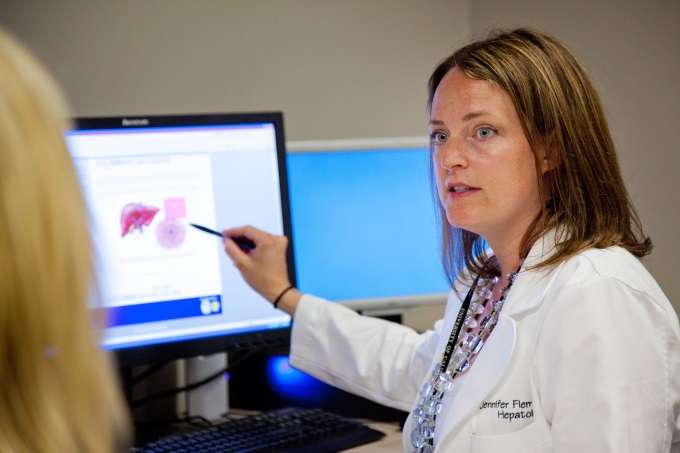Research addresses the burden of liver disease

Chronic liver diseases are steadily growing conditions, estimated to affect one in 10 Canadians. Most chronic liver diseases are "silent", attacking the liver for decades without symptoms until revealing themselves through end-stage liver diseases such as cirrhosis, liver failure or liver cancer.
Queen's researcher Jennifer Flemming, is the first in Canada studying the links between cirrhosis and biliary tract cancer (a rare subset of liver cancer) from both a clinical and population perspective. Key to her work is leveraging information in large patient databases.
"Once you develop cirrhosis of the liver, it puts you at risk of many other complications, such as the need for a liver transplant or the risk of liver cancer," Dr. Flemming, an assistant professor of gastroenterology and a clinician scientist with the Kingston General Hospital Research Institute.
"Unlike breast or colon cancers, where treatments have dramatically reduced mortality, primary liver cancers and associated mortality are on the rise. So cirrhosis and its complications are important diseases to look at."
The most common chronic liver disease is Hepatitis C (HCV), estimated to infect one out of every 100 Canadians, and is most often diagnosed in Baby Boomers.
For patients with the blood-borne virus, HCV imposes a social, as well as a health burden: they feel stigmatized by a disease that is often perceived by society as a consequence of chronic alcohol abuse. It is also an invisible disease: it's estimated that 30 percent of those with the virus do not know how they acquired the infection and a significant proportion of those infected are unaware of their diagnosis.
The Canadian Liver Foundation projects that diagnoses of cirrhosis and liver cancers will peak in 2020, placing an enormous burden on the health care system.
"It's not actually known how many individuals in our province have cirrhosis," she explains. "We have population estimates from other countries, and some North American data, but there's no Canadian data right now that will help us look at this rising epidemic."
The current phase of her research program, conducted in the division of Cancer Care and Epidemiology (CCE) at the Queen's Cancer Research Institute, involves extracting information from pathology reports in patients with biliary tract cancer and looking at the natural history, treatment outcomes, and mortality trends in this population. The next phase of her research will look at the burden of chronic liver disease and cirrhosis in Ontario and the association between cirrhosis and biliary tract cancers.
Her groundbreaking work will enable her to quantify the burden of biliary tract cancer across the Ontario population, and then identify disease trends, risk factors, and outcomes. This will be done by merging her databases at CCE with provincial health records. "Once we do this, we can figure out where more research is needed, who the target populations are for screening, and how and when to treat them," she says.
Long-term, she hopes to use the results of her population-based research to justify the development of a chronic disease management strategy for Canadians with liver disease. "It's important for people to know that the face of the disease is changing, that it's curable," she says.














